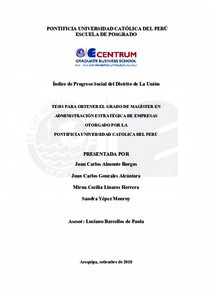| dc.contributor.advisor | Barcellos de Paula, Luciano | |
| dc.contributor.author | Almonte Burgos, Juan Carlos | es_ES |
| dc.contributor.author | Gonzales Alcántara, Juan Carlos | es_ES |
| dc.contributor.author | Linares Herrera, Mirna Cecilia | es_ES |
| dc.contributor.author | Yépez Monroy, Sandra | es_ES |
| dc.date.accessioned | 2018-10-23T22:08:22Z | |
| dc.date.available | 2018-10-23T22:08:22Z | |
| dc.date.created | 2018 | |
| dc.date.issued | 2018-10-23 | |
| dc.identifier.uri | http://hdl.handle.net/20.500.12404/12922 | |
| dc.description.abstract | Se entiende por progreso social a la capacidad que posee una sociedad para satisfacer las
necesidades que sus ciudadanos tienen, mediante la creación de condiciones que permitan a
cada individuo desarrollar todo su potencial. Con base en esto se creó el Índice de Progreso
Social (IPS), que se aleja de las tradicionales mediciones económicas y se concentra en
aspectos sociales y ambientales únicamente. En años anteriores se ha calculado el IPS para
los países y recientemente CENTRUM Católica hizo lo propio para cada una de las regiones
del Perú. Esto permitió identificar que el dato no existía para las provincias y distritos, por lo
que los investigadores se propusieron desarrollar un índice que compare los tres pilares del
progreso social para la provincia de La Unión. Por lo tanto, la presente tesis representa un
gran aporte, revelando la situación actual de la provincia de La Unión a través de un
indicador cuantitativo, y a partir de esta información, las autoridades podrán diseñar sus
políticas y proyectos. A lo largo de este documento, se presenta la situación actual y del
entorno de la provincia de La Unión, localizada en la región Arequipa, en el sur del Perú, con
14,976 habitantes distribuidos en 11 distritos. La metodología aplicada, de acuerdo al IPS,
consistió en un cuestionario construido en torno a tres dimensiones, 12 componentes y 50
indicadores; cuya información se complementó con estadísticas de fuentes secundarias.
Luego de encuestar a 379 personas, tabular y analizar los datos, se encontró que La Unión
tiene un IPS igual a 52.55 lo cual se considera bajo. Además, se concluye que el desarrollo no
es equitativo entre los distritos, mientras que en relación a las dimensiones, el mayor valor se
registró en Necesidades Humanas Básicas y el menor en Fundamentos del Bienestar, por la
falta de acceso a información y comunicaciones, entre otros problemas que tiene la provincia.
Los resultados se consideran altamente confiables ya que el Alfa de Cronbach por elemento
osciló entre 0.70 y 0.85. | es_ES |
| dc.description.abstract | Social progress is understood as the ability of a society to meet the needs of its citizens, by
creating conditions that allow each individual to develop their full potential. Based on this,
the index of social progress (IPS) was created, which moves away from the traditional
economic measurements and focuses on social and environmental aspects only. In previous
years the IPS has been calculated for the countries and recently CENTRUM Católica did the
same for each of the regions of Peru. This allowed to identify that the data did not exist for
the provinces and districts, so the researchers set out to develop an index that compares the
three pillars of social progress for the province of La Union. Therefore, this thesis represents
a great contribution, revealing the current situation of the province of La Unión through a
quantitative indicator, and from this information, the authorities will be able to design their
policies and projects. Throughout this document, we present the current situation and the
environment of the province of La Union, located in the Arequipa region, in southern Peru,
with 14,976 inhabitants distributed in 11 districts. The methodology applied, according to the
IPS, consisted of a questionnaire built around three dimensions, 12 components and 50
indicators; whose information was supplemented with statistics from secondary sources.
After surveying 379 people, tabulating and analyzing the data, it was found that La Unión has
an IPS equal to 52.55 which is considered low. In addition, it is concluded that the
development is not equitable among the districts, while in relation to the dimensions, the
greatest value was registered in basic human needs and the lowest in fundamentals of wellbeing,
due to the lack of access to information and communications, between other problems
that the province has. The results are considered highly reliable since the Cronbach's Alpha
per element ranged between 0.70 and 0.85. | es_ES |
| dc.language.iso | spa | es_ES |
| dc.publisher | Pontificia Universidad Católica del Perú | es_ES |
| dc.rights | info:eu-repo/semantics/openAccess | es_ES |
| dc.rights.uri | http://creativecommons.org/licenses/by-nc-nd/2.5/pe/ | * |
| dc.subject | Indicadores sociales--Perú--La Unión (Arequipa : Provincia) | es_ES |
| dc.subject | Indicadores económicos--Perú--La Unión (Arequipa : Provincia) | es_ES |
| dc.subject | Investigación cuantitativa | es_ES |
| dc.title | Índice de progreso social del distrito de La Unión | es_ES |
| dc.type | info:eu-repo/semantics/masterThesis | es_ES |
| thesis.degree.name | Maestro en Administración Estratégica de Empresas | es_ES |
| thesis.degree.level | Maestría | es_ES |
| thesis.degree.grantor | Pontificia Universidad Católica del Perú. CENTRUM | es_ES |
| thesis.degree.discipline | Administración Estratégica de Empresas | es_ES |
| renati.advisor.cext | 001534456 | |
| renati.advisor.orcid | https://orcid.org/0000-0003-4249-0565 | es_ES |
| renati.discipline | 413307 | es_ES |
| renati.level | https://purl.org/pe-repo/renati/level#maestro | es_ES |
| renati.type | https://purl.org/pe-repo/renati/type#tesis | es_ES |
| dc.publisher.country | PE | es_ES |
| dc.subject.ocde | https://purl.org/pe-repo/ocde/ford#5.02.04 | es_ES |






